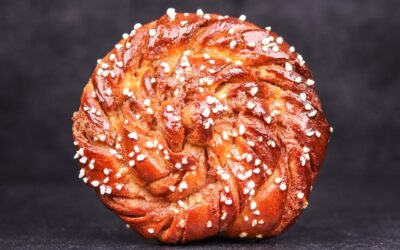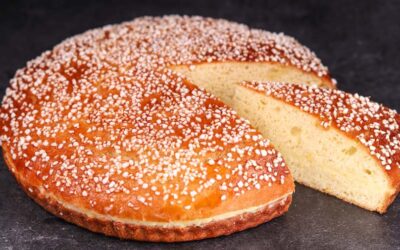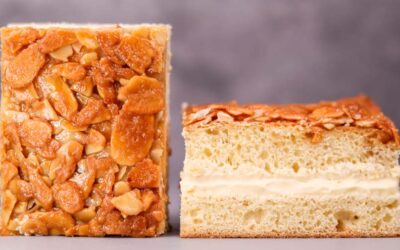Out of all the bread dough recipes on my channel brioche was the only one that I ever used a mixer for. I always thought that hand mixing brioche dough would be pretty much impossible.
Brioche can contain up to 50% butter. My regular recipes used 40% which is a large amount still. Along with butter it contains 50% egg, which is made up of around 6% fat which contributes to the total fat content even further.
I think we can say that it is one of the richest doughs out there.
All the butter, eggs, and sugar make the dough sticky and difficult to work with. Fat inhibits gluten formation and that is why it takes increasingly longer to knead a dough with a high fat percentage.
The longer a dough is kneaded the more it will heat up. Temperature control is one of the most important parts of breadmaking. A controlled and predictable fermentation is what we want. Aiming at 25C – 26C (77F – 79F) for a cold bulk fermented dough like this presents some challenges.
When using a mixer, it can take up to 25 minutes of mixing. All ingredients must be stone cold. It is even advisable to chill the mixing bowl and to freeze the dough hook.
At this point I’m sure you can see why I always thought that making it by hand is impossible.
So, I took my regular brioche and reduced the butter by 10%. It is still a super-rich dough, and I can say for certain now that it can be made with the full 40%. The rest of the ingredients are the same.
I froze the flour to around -5C (23F) and I chilled the eggs and water to around 4C (39F). The mixing bowl could also be chilled if your kitchen is warm. I treated the butter the same way as other brioche recipes and kept it cold. To make it pliable and soft I pressed it between sheets of non-stick paper using a rolling pin. All these measures are important for temperature control.
My hands are warm. Really warm. And my wooden table is quite warm too. If you have a stonework surface, then you may need to use warmer ingredients.
Not to complicate the recipe I decided to stick to almost the same ingredients and techniques as in my regular machine mixed brioche, but simply swap machine kneading for hand kneading.
And it works out perfectly. Initial kneading by pressing against the table for 10 minutes to get the gluten going, and 15 more minutes of stretch & folds to incorporate the butter and finish gluten development. As it turns out it takes the same amount of time as machine kneading. The final dough temperature was on point too at around 25C (77F). This is thanks to the cold butter and the fact that the stretch & fold method does not warm the dough up that much.
A couple of folds during the first couple of hours of chilling and then a long cold bulk ferment for up to 24 hours and the dough is ready for use.
This is what it takes to make brioche by hand. It is a bit of a workout. Especially the first 10 minutes kneading the sticky dough, but it’s well worth the effort especially if you don’t own a mixer.
Watch the video down below for detailed instructions.
Ingredients
For the dough –
500g (1.1lb) white bread flour
45g (1.6oz) water
250g (8.8oz) eggs
13g (0.45oz) salt
60g (2.1oz) sugar
8g (0.28oz) instant dry yeast or 9.6g (0.33oz) active dry yeast or 24g (0.84oz) fresh yeast
150g (5.3oz) butter
To learn more about dough temperature control click here.
Method
- Make sure all the ingredients are cold!
- In a large bowl combine the eggs, water, yeast, salt, and sugar. Mix well to dissolve the salt and sugar. Add the flour and mix to a dough. Tip the dough out on the table.
- Knead for 10 minutes. It will stick to the table and to your hands. Use the dough scraper to scrape the dough together occasionally and continue kneading. The dough will still be quite sticky after the 10 minutes. This is due to the eggs and sugar.
- Stretch the dough out and add the butter. Fold the dough around the butter. Press and squeeze the dough for at least one minute. Try and force the butter into the dough.
- Once the butter has been incorporated continue kneading the dough using the stretch & fold method. This stage will take 15 minutes. Don’t get discouraged because of the length of time. The stretch & fold is far easier than the initial 10-minute mix. It is quite therapeutic and pleasant. *Desired dough temperature 25C – 26C (77F – 79F).
- Place the dough in a bowl, cover, and chill for 1 hour.
- Fold.
- Cover and chill for 1 more hour.
- If you want to use the whole dough for one project, then leave it as it is. If you want to use it for two projects (like I do and suggest), then divide it in half and shape the two halves in balls.
- Wrap in clingfilm and cold ferment for up to 24 hours. You can leave it to ferment for longer too. I used the second dough ball after 48 hours and it worked just fine.
- When you are ready to continue take dough out and use if for which ever project you like. This dough can be used for any of the brioche recipes on my channel. If you want to follow this video and make burger buns, then divide it into 4 equal pieces.
- Pre-shape lightly into balls.
- Leave to rest for 30 minutes.
- Final shaping.
- Final proof will take around 4 – 5 hours depending on the temperature of your kitchen. You can place them in a warmer area to make them ferment more rapidly.
- Glaze and sprinkle with seeds.
- Bake at 160C (320F) fan on for 25 minutes.
Cool down and enjoy!
Keep in mind that the conditions in each kitchen are different, so fermentation times may vary for you. It is up to the baker to control the bread and react accordingly.
Your oven may be different too, so your baking time may vary.
Watch the video here



